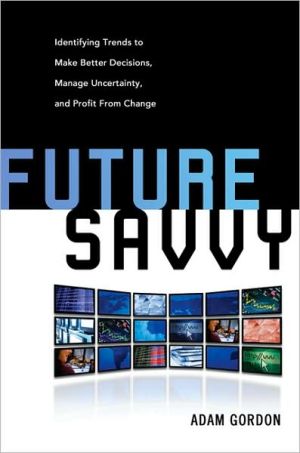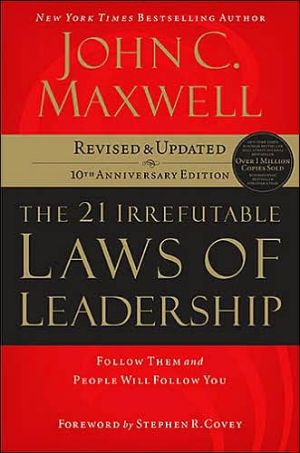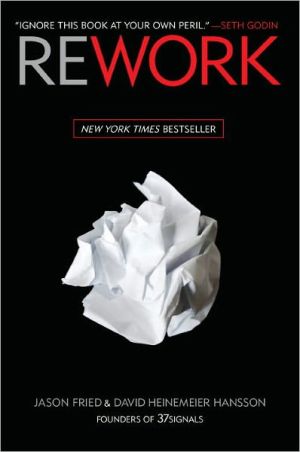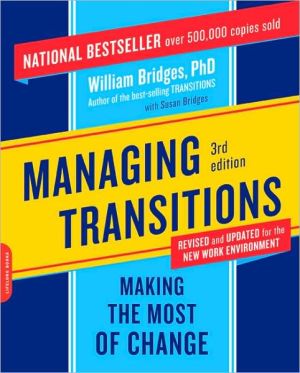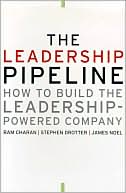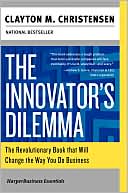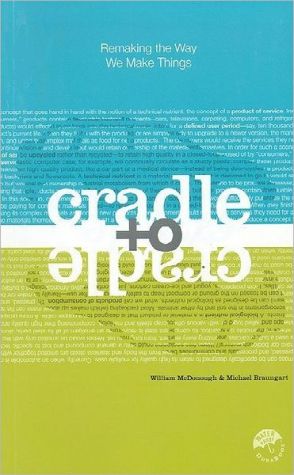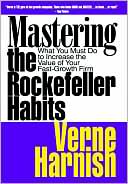Future Savvy: Identifying Trends to Make Better Decisions, Manage Uncertainty, and Profit from Change
There is no shortage of forecasting available to businesses looking to anticipate and profit from future trends. But what information, from the endless sea of sources, is valid? How do you know which predictions to take seriously, which to be wary of, and which to throw out entirely? Most important, which ones do you let guide your business’s decisions?\ \ As huge an industry as business forecasting is, it’s a wonder how amorphous it remains. As explained by author Adam Gordon, there is...
Search in google:
There is no shortage of forecasting available to businesses looking to anticipate and profit from future trends. But what information, from the endless sea of sources, is valid? How do you know which predictions to take seriously, which to be wary of, and which to throw out entirely? Most important, which ones do you let guide your business’s decisions? As huge an industry as business forecasting is, it’s a wonder how amorphous it remains. As explained by author Adam Gordon, there is virtually no regulation, no serious accountability, and no quantifiable track record. “There is no accepted conceptual framework, agreed professional standards, or guidelines for application to policy or business decision making.” In fact, there’s not even a clear definition of what forecasting is. That said, it is unwise to discount the importance of forecasting. After all, your company’s decisions will play out not in the present, but in a future that is bound to be different. What will the financial landscape be months or years from now? How will technology affect your company and your industry? What factors will shape the demand for your product or service? Understandably, it is imperative that you attempt to predict the future business environment, lest you be caught flat-footed by the ever-increasing pace of change. Future Savvy gives you a battery of critical tests to apply to any forecast in order to assess its validity and its relevance to your business’s strategic decisions. In sifting through the endless reams of information you receive in the form of predictions, you will now be able to: Distinguish between (and apply) future-aligning versus future-influencing forecasting Combine short-, medium-, and long-term forecasting to create a three-dimensional model of the future Decrease reliance on so-called “hard” data that may not be as inarguable as you think See through biases in research, consider the source and motivation behind any analysis, and approach information from the perspective most relevant to your organization’s needs Assess the value of forecasting as it pertains to the nature and timing of specific outcomes Avoid the common pitfalls in trend-based forecasting and use better alternatives Develop multiple future scenarios And more The author synthesizes all of these powerful analytical tools into a template that allows you to apply “forecast filtering,” a systematic deconstruction that accounts for all possible sources of inconsistency, fallibility, or bias in any presentation of predictive information. Remember, the information you receive is only as solid as the approach you take to its interpretation. If your decisions are ill-informed, no one will blame the forecasters, whoever they may have been. Using the approaches in Future Savvy, you stand a much better chance of parlaying information into strong results, and “when you come across yet another breathless article about the latest new thing, you will have the tools to keep your head when all about you are losing theirs.” Adam Gordon is an expert in the field of industry foresight and future studies. He has been an analyst, consultant, facilitator, and professor, and has appeared on NPR’s Morning Edition and CNN World Report. He also writes, teaches, and consults for The Future Studio and was previously a Senior Associate at Coates & Jarratt, Inc., a future strategy consulting organization in Washington. Mr. Gordon lives in Cardiff, Wales.
INTRODUCTION\ This book is about how to evaluate forecasts and extract value from them. It is written to help decision makers in commercial, policy, and nonprofit sectors, as well as ordinary people in daily life, make better judgments about predictions they read and hear, so they can appropriately plan for and profit from the future.\ Predictive statements are all around us: in the newspapers, on TV, at conference presentations, in industry reports, consulting documents, think tank studies, and so on. All claim to be valid, but the record shows that few are. So while forecasts are a crucial decision-success resource, they are not in themselves valuable. they are only valuable alongside a clear way to separate the wheat from the chaff. What’s valuable is being able to critically judge this torrent of information and to be able determine which ideas are worth taking seriously—worth planning for and investing in.\ This book sets out to communicate tools and approaches that the forecast consumer can use to filter and evaluate statements about the future and thus judge what the real threats and opportunities are. It summarizes and orders the problems common in forecasting, as well as best practices, so that managers and decision makers of all types may be better able to critically interact with the barrage of forecasts that compete for their attention and resources and discriminate between worthy and unworthy ones.\ Teaching a Donkey to Talk: Why Forecasts Can’t Be Trusted\ There’s an ancient Uzbek parable about a con man who promised a local nobleman he could teach a donkey to talk—for a large fee—but it would take twenty years. Of course, in twenty years the con man, the nobleman, or the donkey would be dead.1 Predicting is safe for the same spurious reason. By the time outcomes emerge, there is almost never anybody around to say, “Hey, that never happened!” And even where there is anyone who remembers the tarnished pearls of predictive wisdom, there is of course no penalty for being wrong. There’s no skin in the game. The predictor may feel a twinge of embarrassment perhaps, but then, who can get it right all the time?\ Not only is there no recourse, but putting predictions out into the world is ridiculously easy to do. Anyone can read a few articles, gather the direction of technology and social trends, and make projective links. The forecasting field is not regulated. There is no accepted conceptual framework, accepted methods, agreed professional standards, or guidelines for application to policy or business decision making.2 There is no oversight board or council or licensing mechanism, no organization to which one must belong, no minimum qualifications, no agreed or standard curriculum in teaching forecasting. Anyone with a keyboard or a microphone, it seems, is welcome to babble on about digital media or nanotechnology or climate change or any other hobby horse, and before we know it, we are knee-deep in predictive wishful thinking, scare-mongering, or blatant self-promotion, much of which is not worth our attention.\ Part of the lack of standardization means there is no agreed definition of terms. In this book, I’ve used forecasting, foresight, predictions, and future studies more or less interchangeably to refer to works that look to and try to interpret the future. Some analysts use “forecasting” to refer to technical mathematical approaches, and “foresight” to refer to more impressionistic approaches.\ Why We Don’t Ignore Forecasts: Why the Future Matters\ Rapid change is a constant, ubiquitous feature of our lives. We have seen eye-popping developments across society, technology, institutions, and products and services in the last generation; this will surely continue into the future. But change is not merely interesting. It is competitive. This is because success always implies congruence between decisions and the world in which those decisions play out. If we decide today to launch a product, buy a house, study for a degree, build a new light rail system, or take any similar decision of significance, the environment of tomorrow will be a key factor in the success or failure of that decision. What we do will be tested by the future conditions that emerge. Where there is a good “fit” between the initiative and the environment it plays out in—“the right product at the right time”—we can expect success. If not, we should expect to fail. Our decisions are only as good as the view of the future they rest on. All opportunities and successes and profits are realized in the future. All threats, failures, and losses are in the future.\ In a fast-moving world, we know that the future environment will be different to that of today in big or small ways. New technologies, market shifts, changes in legislation, or evolving social values damage or destroy the traditional good fit we have between ourselves and the world. To achieve “future fit” we therefore use forecasts to position ourselves and our organizations, creating (or renewing) the fit between our initiatives and environment. In some cases we may be strong enough also to influence future events and outcomes for our own future benefit, and forecasts help us do this too. Either way, the earlier and clearer we see future circumstances, the better we will be able to benefit by changing our current recipes for success to keep up with the changes in the world. The better managers’ view of the future, the better their decisions will turn out to be.\ All enterprises benefit from narrowing down what they must adapt to and plan for—all effort spent preparing for a future that will not emerge is a waste of personal or organizational resources. Good forecasts are a key ingredient in limiting the vagaries of uncertainty, and therein working smarter not harder, avoiding surprises, exploiting new opportunities and plugging weaknesses in fitting in with the future, and where possible influencing the future to suit the organization. This is true not only of business. People and institutions of all types position themselves for success by anticipating and adapting to events, or shaping them. Whether it is an NGO raising money for developing-world children, an urban planner advocating a light rail system, a homeowner deciding to sell a house, or a student making a career choice, identical principles apply—a higher-quality reading of the future operating environment in which these decisions will play out is what separates winners from losers. We should all be vitally concerned with forecasts as we are all effectively betting significant resources on their validity.\ So, as individuals and organizations, we are all faced with the task of grappling with the changing world under competitive conditions. Little surprise, then, that we appear “hard-wired” to seek information about changing circumstances and manifest a desire to peer ahead or absorb the insight of those who do. To be competitive we must be reading and listening to forecasts and factoring them into our world view and our plans. We cannot afford to ignore the forecast chatter. This is compounded by the rapid growth of information. The days of the panoptic amateur intellect are over. There’s just too much to know in too many specialized fields. Whether we need to consider decisions concerning the future in healthcare, transport, education, or any one of a thousand areas, we find we are often required to call on specialists in those areas. Being forced to build our picture of the world on the expertise of others, we are, whether we like it or not, retail consumers of others’ forecast perceptions.
Acknowledgments ix Introduction 1 Chapter 1 Recognizing Forecast Intentions 17 Chapter 2 The Quality of Information: How Good Is the Data? 39 Chapter 3 Bias Traps: How and Why Interpretations Are Spun 61 Chapter 4 Zeitgeist and Perception: How We Can't Escape Our Own Mind 83 Chapter 5 The Power of User Utility: How Consumers Drive and Block Change 105 Chapter 6 Drivers, Blockers, and Trends 133 Chapter 7 The Limits of Quantitative Forecasting 153 Chapter 8 A Systems Perspective in Forecasting 173 Chapter 9 Alternative Futures: How It's Better to Be Vaguely Right than Exactly Wrong 197 Chapter 10 Applying Forecast Filtering 215 Chapter 11 Questions to Ask of Any Forecast 263 Further Reading 285 Index 289
\ From the Publisher"Future Savvy…will help you become a better consumer of forecasts, from economists, governments, think tanks and, yes, even journalists." The Globe & Mail (Toronto)\ "a book that will make fascinating reading for anyone involved in forecasting" --Foresight Magazine\ “If you care at all about preparing for the future, read this book.” -- Online Magazine\ "Given recent developments in the US economy and their implications and probable impact insofar as the global economy is concerned, the publication of this book is indeed timely." -- Dallas Business Commentary Examiner\ "...a guide for prognosticators and scenario planners, a set of warnings against such common errors as overreliance on numbers, overlooking your own bias, and ignoring the oscillations of history…” -- Strategy+Business\ "… offers a great deal of common sense that often gets left behind in analytics and forecasting…” -- Inland Empire Business Journal\ "...Gordon's book will be a useful primer and refresher on the art of proper forecasting and on detecting the artifice and subtlety of persuasion via anticipatory declaration." --Research Technology Management\ \ \
